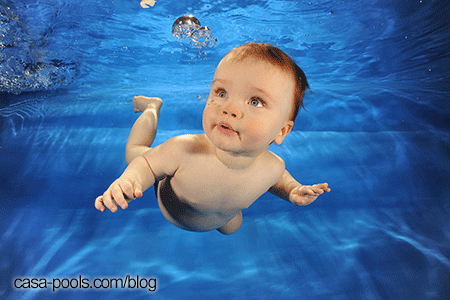|
|
|
Published On: February 20, 2014
By: Kevin Allen, Washington
|
GENERAL CATEGORY
|
SWIMMING WITH YOUR BABY
|

|
|
swimming with your baby
|
Getting your baby used to water early in his life makes sense from a safety point of view. Swimming is also great fun and good exercise too. Heres some advice on taking the plunge.
When can I start swimming with my baby?
It`s best that you wait until six weeks after your baby`s birth before you go swimming. If you go swimming sooner there is a chance you may pick up an infection. If youve had a caesarean section or stitches your health visitor or GP may recommend that you wait longer than six weeks.
If you are keen for your baby to be introduced to swimming before he is six weeks old your partner, or someone else, can take him. Some private baby swimming classes start at four weeks, but most start at six weeks. There is no need to wait until your baby is immunised before taking him to a pool.
If your baby is younger than six months old only take him to a pool that`s heated to about 32 degrees C. It`s best to go to baby swimming lessons which use warm pools for young babies (see below, How do I find out about baby swimming lessons?). Big, public pools are too cold for young babies.
What will I need to take?
Top of the list will be reusable swim nappies. Accidents can happen! You`ll also need to pack:
A warm bottle for after the swim if you are bottle feeding.
A towel, preferably one with a hood, or a towelling dressing gown.
A snack if your baby has started solids. Swimming makes babies hungry.
A few of your baby`s bath toys to encourage a relaxed, fun atmosphere.
Changing mat and nappy bag.
How do I keep my baby safe in the water?
Make sure the pool is warm enough. If necessary, ask the pool attendants to check the temperature for you. Babies under six months need a temperature of about 32 degrees C.
As soon as your baby starts to shiver, get him out of the pool and wrap him up warmly.
Start off with sessions of 10 minutes and build up to 20 minutes. If your baby is under a year old, limit your time in the water to 30 minutes.
If your baby has a bad cold, a temperature or seems unwell, don`t go swimming. Also, your baby should not swim with a tummy bug and should not go swimming until he has been clear for at least 48 hours.
If your baby has a skin complaint, check with your GP to make sure that the chlorine won`t irritate him.
I`m taking my baby to the pool on my own. Any tips?
Start by getting your baby used to the water. Make bath time fun. Gently splash water over his body or lay him on his back and move him gently through the water.
When you first visit a public pool, pick a time when its not too busy. Phone ahead to find out if there is pushchair access and changing tables. Ask a friend to come with you or join a mum-and-baby session (see below, How do I find out about baby swimming lessons?). If you feel relaxed and confident, your baby will too.
There are lots of things you can do to make swimming fun for your baby and help boost his confidence in the water:
When you get in the pool, hold your baby close and keep eye contact with him.
When you feel more confident, try extending your arms and swishing your baby around.
Talk to him and praise him all the time.
Let your baby splash and play with his bath toys. Throw one a few feet across the pool and "zoom" him through the water to retrieve it.
Put your mouth under water and show your baby how to blow bubbles. This is an important lesson for him, as he can`t inhale water if he is blowing. If your baby is very young, blow a toy across the water and get him to blow it back or at least copy you blowing.
When he can sit up, put him on the side of the pool and sing Humpty Dumpty. When you get to the line "Humpty Dumpty had a great fall" lift him down into the water with a splash.
Lay him on his back with his head resting on your shoulder. Encourage him to kick his legs.
Im not confident in the water, should I still take my baby swimming?
Even if you`re not keen on being in the water, you can make sure your baby gets the benefits that come from learning to swim.
You could try going for a few swims on your own in your local pool before taking your baby with you. Or you could enrol in a baby swim class. This will probably boost your confidence as much as your babys, and is a good way to meet other mums.
Learning to enjoy the water with your baby will strengthen the bond between the two of you as well as making you feel more positive about swimming.
What happens at baby swimming classes?
Baby swim classes are usually made up of about 10 mums, dads and babies and are held in small, warm pools. The classes are usually arranged by ability. If you join a beginner`s class it will be everyone elses first time too.
Baby swim teachers aim to make their sessions relaxed and fun, and to encourage learning through play. Young babies are born able to do primitive swimming strokes. Your teacher will build upon these natural reflexes until your child is completely happy moving in and through the water.
Once the two of you are in the water, hold your baby in a way that allows you to keep eye contact. Give him constant praise to build his confidence. Your support and encouragement helps him to feel safe and secure.
Once your baby is confident in the pool, your teacher may encourage your baby to try swimming under water. Its natural for you to feel anxious the first time you and your baby try this, but try not to worry.
Babies have a natural affinity with water. Plus, your baby`s inbuilt gag reflex is generally strongest up to six months old. This reflex allows him to hold his breath under water without even thinking about it.
|
|
|
|
|
